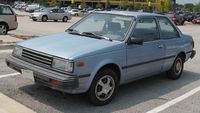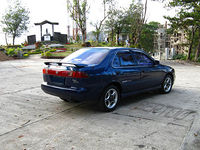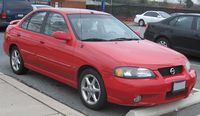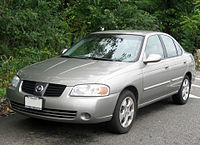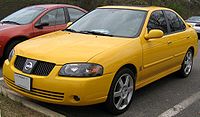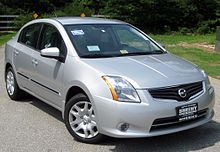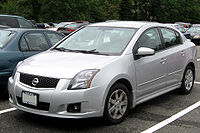- Nissan Sentra
-
Nissan Sentra 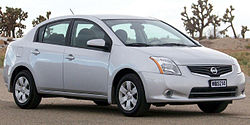
Manufacturer Nissan Production 1982–present Predecessor Nissan Sunny Class Subcompact (1982–2000)
Compact (2000–present)Related Renault Mégane The Nissan Sentra is a compact car produced by automaker Nissan Motors and is generally a rebadged export version of the Japanese Nissan Sunny. The name "Sentra" is not used in Japan.
In the United States, the Sentra currently serves as Nissan's compact car and the prices range from $15,478 for a base model to $23,478 for a loaded top-of-the-line Sentra. While previous Sentras were subcompact cars, the Sentra has grown over the years, and now the Nissan Versa has replaced the Sentra in the entry-level area, although it is rated by the US EPA as a mid-size car due to its interior volume.[1]
Contents
International Markets
The Nissan Sentra was introduced for the 1982 model year as the US export name for the Nissan Sunny (Named after a famous Japanese mobster[citation needed]) . Many other countries in the Americas, such as Bolivia, Brazil and Chile sell their versions of the Sunny as the Sentra. In Mexico, the first three generations of the Sentra were known as the Tsuru (Japanese for Crane), and the 1994 model is still sold under that name, having gone through three facelifts, alongside the current Sentra.
B11 (1982–1986)
First generation 
Also called Nissan Tsuru Production 1982–1986 Assembly Smyrna, Tennessee[2]
Cuernavaca, Morelos, México[citation needed]
Zama, Japan[2]Body style 2-door sedan
3-door hatchback
4-door sedan
5-door station wagonLayout FF layout Engine 1.5 L E15 I4
1.6 L E16 I4
1.7 L CD17 diesel I4Transmission 4-speed manual
5-speed manual
3-speed automaticWheelbase 94.5 in (2,400 mm) Length 167.3 in (4,249 mm)
172.2 in (4,374 mm) (wagon)Width 63.7 in (1,618 mm) Height 54.5 in (1,384 mm)
53.5 in (1,359 mm) (wagon)The first generation of the Nissan Sentra was introduced in the United States in May 1982 as a direct replacement for the Datsun 210.[3] Initially the model was imported from Japan, where it was produced at Zama plant.[2] Available in four body styles (two-door sedan, four-door sedan, five-door wagon and three-door hatchback coupe), it was the second car to be marketed in the United States under the nameplate of Nissan and using a model name instead of a number. The first one was the Nissan Stanza, introduced in the 1981 New York Auto Show as a 1982 model. While previous Sunny models had used a front-engine, rear-wheel drive layout, the B11 Sentra was the first to use a front-engine, front-wheel drive layout. Engine choice was the 67 hp (E15) 1.5 L four-cylinder SOHC,[4] replacing the old A-Series OHV. This featured semi-hemispherical combustion chambers, high-swirl intake ports and a semi-dual exhaust manifold to provide strong torque at low and medium rpm ranges. Torque peak was 85 fl-lbs at 3,200 rpm. Transmission options were a four-speed manual, 5-speed manual or a three-speed automatic with lock-up torque converter. Drag coefficient was 0.39 for the coupe and 0.40 for two- and four-door sedans.[4]
At the time of its release, the Environmental Protection Agency (EPA) gave the Sentra MPG the highest gasoline mileage among gasoline powered cars sold at that time, 43 miles per gallon in city and 58 miles per gallon in highway, a combined 48 miles per gallon.[5] Curb weight of only 1,875 pounds helped it to achieve that number. The Sentra MPG was a special configuration that featured a three-way exhaust catalyst and an electronically controlled fuel metering unit to monitor the air-fuel mixture automatically and make adjustments to boost fuel mileage.[6]
Trim levels were standard, Deluxe and XE, while price range were between US$ 4,949 for the base two-door sedan up to US$ 6,899 for the two-door XE hatchback coupe. Standard equipment on all models were four-wheel independent suspension, front disc brakes and rear drums, rack and pinion steering, maintenance free battery, rear ashtray and buck seats. Deluxe models added halogen headlamps, remote-locking gas filler door, carpeted trunk and rear wiper-washer on the wagon. Deluxe and XE offered tinted glass, trip odometer, vanity mirror, dual remote mirrors and door trim. XE offered cut pile carpeting, analogue quartz clock, remote rear window opener, low-fuel warning light, AM-FM Clarion stereo radio, power steering, tachometer and 155/13 whitewall radial tires.[5] Sunroof was available as an option.
The Sentra quickly became a success, partly due to the appeal of low fuel consumption. In its first year of sales, it was already the best-selling import in the U.S. and the fourth best-selling passenger car overall, with 191,312 units sold.[7] The Sentra ended the 1983 year as the eighth-most sold passenger car, with 209,889 units.[8]
The 1983 model-year introduced a 1.7 L CD17 I4 diesel engine, mated with a four-speed manual transmission. Also, the 1.5 L was replaced by a 69 hp 1.6 L E16 as the standard engine, available with a five-speed manual or three-speed automatic. Later that year the Sentra also received an electronically controlled carburetor.[9]
In April 1985, Nissan started production of the Sentra in the Smyrna, Tennessee plant, after a US$ 85 million investment.[2] The 1985 model-year received minor exterior changes: aerodynamically-styled headlamps, a new grille and blackwall tires replaced the old whitewall tires. A sporty SE option was introduced. The SE was only available in the two-door hatchback model and included alloy wheels, black lower body paint and black out grille. Also, automatic transmission was optional on all Sentras except two-door base sedan, MPG Diesel and SE coupe. Prices were starting at US$ 5,499.[10] Diesel engine was discontinued in the U.S. market. Consumer Reports magazine ranked the B11 reliability as "better than average" in 1985.[11]
Regarding the safety of the B11 model, it was ranked the seventh most safe car in a rank made by the Center for Auto Safety in 1983, which examined the National Highway Traffic Safety Administration (NHTSA) testing, consisting of frontal crashes at 35 miles per hour.[12] However, it is important to consider that safety standards and security level of the models themselves at that time were much different than today.
In Mexico it was called the Datsun/Nissan Tsuru, some rare early models still had the Datsun badge, but it was soon replaced for the Nissan badge, also the three-door hatchback was known as the Nissan Samurai and it was offered with a performance package called "Ninja" which included a low boost Turbo and Ninja stickers on the low side of the doors.[citation needed]
In South Africa the four-door sedan was called the Langley. It was marketed alongside a 1.5-litre coupé known as the EXA. A three-door hatchback was marketed as the Pulsar. Turbo models were available for the Langley and EXA, with the 1.5-litre turbo Langley known as the Langley SSS. Non-turbo Langley models were available as the Langley L, Langley GL and Langley SGL.[citation needed]
It was sold in the United Kingdom as the Nissan Sunny in 1.3 DX, 1.3 GL, 1.5 DX, 1.5 GL, 1.5 GL Auto, 1.5 SGL and 1.5 SGL Spirit variants.[citation needed] A station wagon version was offered; many of these still survive today.[citation needed]
B12 (1985–1990)
Second generation 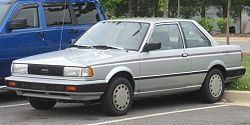
Also called Nissan Tsuru II and Nissan Sunny Production 1985–1990 Assembly Smyrna, Tennessee
Cuernavaca, Morelos, México
Oppama, Japan
Santa Rosa, Laguna, PhilippinesBody style 2-door sedan
3-door hatchback
4-door sedan
5-door station wagon
2-door coupeLayout Front engine, front-wheel drive / four-wheel drive Platform Nissan B platform Engine 1.4 L GA14DE I4
1.6 L (96.7 cid) E16(s) I4
1.6 L (96.7 cid) E16(i) I4
1.6 L (96.7 cid) GA16(i) I4
1.7 L (102.7 cid) CD17(i) I4Transmission 4-speed manual
5-speed manual
3-speed automaticWheelbase 95.7 in (2,431 mm) Length 168.7 in (4,285 mm) (sedan)
166.5 in (4,229 mm) (coupe)
162.4 in (4,125 mm) (hatchback)
172.2 in (4,374 mm) (wagon)Width 64.6 in (1,641 mm) (sedan, wagon & hatchback)
65.6 in (1,666 mm) (coupe)Height 54.3 in (1,379 mm) (sedan & wagon)
52.2 in (1,326 mm) (coupe)
55.3 in (1,405 mm) (hatchback)
54.9 in (1,394 mm) (4WD wagon)This generation carried on the multitude of body styles that the B11 had, including station wagon, 2 and 4-door sedans, 3-door hatchback and the Sport Coupe. The B12 chassis was first produced and marketed in 1985 in most parts of the world; however, was first offered to the United States in 1986. For 1987, all Sentras but the Sport Coupe came standard with the E16(s) with 69 hp (51 kW) and a 5-speed manual transmission. In 1988, all Sentras had the 70 hp (52 kW) E16(i), which was offered for this year with throttle body injection (TBI). In many parts of the world the E series soldiered on in the B12 chassis with some getting the multi-point fuel injection E16E engine. Diesel engines were also offered in some models, but were rare and only available in North American 1987 models and in certain parts of the world. From 1989 to 1990, the only engine choice was the 90 hp (67 kW) GA16i, a 12-valve SOHC version of the later GA16DE. Transaxles offered were the 4- and 5-speed manuals and 3-speed automatic with torque converter lockup.
The B12 carried over a radically modified 4-wheel independent suspension from the B11, with 4-wheel disc brakes an option in some parts of the world. This was the start of the model classes which were standard through the 2003 model year (not all classes were available every year) having the "E" as the base-level economy car, the "XE" as the next-up model, the GXE as the top level for the 4-door sedan, the sporty "SE" coupe, and the "SE-R" (Not available in the US market) as the top of the line performance model. The GXE (available from 1987 to 2003) had a body colored bumper, aero side mirrors with manual remote control, tachometer as well as standard 13" 175/70/R13 alloy wheels along with air-conditioning, variable intermittent wipers, but no standard cassette deck nor any power windows/locks/mirrors. The SE also had dual mirrors, air conditioning, tachometer, and power door locks and windows in some markets and possibly electronic fuel injection. Back seats only came with safety lap belts and shoulder belts didn't exist until 1990.
The B12 chassis would be the last chassis to offer a station wagon model, which was marketed as the "California" in some Asian markets. Even more rare are the four-wheel drive versions of the station wagon, offered as an option in 1987, 1988 and 1989 model years. These models featured an electrically-activated 4WD single-range transfer case to drive the independently-suspended rear wheels, making them selectable four-wheel-drive—not all-wheel-drive—vehicles. The North American 1987 four-wheel-drive Sentra wagon and the Sentra Sport Coupe hatchback are the only Sentras of their year to be offered with Throttle-Body Injection (TBI) as standard equipment.
1989 also saw a subtle change in the body style of the Sentra coupe and sedan, as new larger, more rounded front corner lights were introduced to the front fenders and redesigned taillights were added to the rear fascia. Also, the Nissan logo on the front grille was relocated from the right hand side to the center. In 1990, electrically-retracted front shoulder belts were added, as well as 3-point harnesses for the rear passengers, excluding the center rear passenger.
The Sport Coupe was a sportier style of the Sentra. It shared few if any of the body panels with the standard model. It was only available with the E16i or GA16i, and did not receive Nissan's CA18DE that was offered in the Sunny ZX Coupe. All Sport Coupes had dual sway bars, dual remote-adjust mirrors, and a tachometer next to the speedometer. The SE model added features like air conditioning and rear speakers. All B12 Sentras used the same wiring harness, regardless of options installed on any particular vehicle.
In Mexico the Sentra was known as a Nissan Tsuru II (as the first generation was simply called Tsuru) and the Sport Coupe 3 door hatchback was known as the Nissan Hikari, it was marketed as a complete different model from the Sentra and it was Nissan's sports flagship car as it was even offered with a low boost Turbo.
B12s are known for reliability and great fuel economy, and are considered by enthusiasts to be good low budget project cars due to interchangeability of parts with other Nissan models.
In Kenya (East Africa), the B12 is imported and marketed as Nissan Sunny and comes with a 1.3 or a 1.5 litre Petrol Engine. The 1.3 litre version is assembled locally (1.3 SLX) and is known for greater reliability than the imported versions.
In Canada, the B12 four-door sedan remained available through the 1993 model year. Essentially a re-badged Nissan Tsuru II built in Mexico, it was called Sentra Classic to distinguish it from the B13 model released for 1991. It replaced the Nissan Micra 3/5-door hatchbacks which were discontinued that time as a price-leader model. All 1991-93 "Classic" models came with the 70 hp (52 kW) E16i and the choice of two transmissions, a 5-speed manual or 3-speed automatic.
In the Philippines, it was initially offered in three trims namely the 1.7 DX (diesel), 1.3 SLX and the 1.5 SGX, the wagon version was also available in the 1.5 SGX trim and was called the Nissan California. In mid 1989, the Sentra model line was freshened up and the engines were upgraded to 1.4 (LX) and 1.6 liter. The 1.6 SGX gained power steering, windows, door locks and side mirrors, a first in its class. The second generation B12 also had a diesel variant which had the 1.7 CD17 engine. The second wagon version (known as Nissan California 1.6 SGX)also had all power features.
B13 (1991–1994)
Third generation 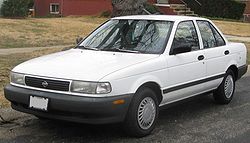
Also called Nissan Sunny
Nissan Tsuru III
Nissan V16Production 1991–1994 Assembly Smyrna, Tennessee
Cuernavaca, Morelos, México
Oppama, Japan
Santa Rosa, Laguna, PhilippinesBody style 4-door sedan
2-door coupeLayout FF layout Platform Nissan B platform Engine 1.4 L GA14DE I4
1.6 L GA16DE I4
2.0 L SR20DE I4Transmission 5-speed manual
4-speed automatic 4-speed manual
3-speed automaticWheelbase 95.7 in (2,431 mm)
Tsuru: 2,430 mm (95.7 in)Length 170.3 in (4,326 mm)
Tsuru: 4,325 mm (170.3 in)Width 65.7 in (1,669 mm) (1993-94)
65.6 in (1,666 mm) (1991-92)
53.9 in (1,369 mm) (coupe & 1991-92 sedan)
54.1 in (1,374 mm) (1993-94 sedan)
Tsuru: 1,650 mm (65.0 in)Height 53.0 in (1,346 mm)
Tsuru: 1,381 mm (54.4 in)Curb weight coupe 2,266 lb (1,028 kg)
4 dr 2,288 lb (1,038 kg)The sedan came standard with the fuel injected 110 hp 1.6 L GA16DE engine. It came in the base model, E, XE, GXE, SE, And Limited Edition. The GXE and Limited Edition came with power package such as power windows/locks/mirrors while the XE, SE, SE-R came with standard or optional sunroof and alloy wheels. Four door models came with front motorized shoulder seatbelts.
SE-R
The B13 was the first to offer Nissan's famous and then-new SR20DE engine in the sporty two-door SE-R model. Setting subcompact speed records of the time, the Sentra SE-R came with 140 hp (104.4 kW) at 6400 rpm and 132 lb·ft (179 N·m) of torque at 4800 rpm. It could accelerate from 0 to 60 mph (100 km/h) in 7.6 seconds and the quarter-mile in 15.8 seconds. It came with 4-wheel disc brakes and had a MacPherson strut independent suspension. Further improving the handling was a viscous limited-slip differential, which was standard equipment on the SE-R. The B13 SE-R returns 21 MPG city/29 MPG highway.[clarification needed] [1].
Nissan Tsuru/V16 (1992–present)
The Mexican-made Sentra B13 is still sold in Mexico as well as parts of Central America and South America. It's called the Nissan Tsuru in Mexico, Nissan V16 in Chile, Sentra 1.6 in Bolivia, Sentra B13 in Panama, and Sentra Clásico in Peru and Dominican Republic. It is the same basic car only with minor cosmetic changes and mechanical downgrades to make it cheaper, such as non-power steering, downgraded interior trim, a downgraded braking system, and a mechanical clutch instead of a hydraulic one. More recent models have received a Renault-built hydraulic clutch. Its affordable price make it popular among local taxi drivers in Mexico, South America, Central America, and the Caribbean.
In the Philippines The B13 was released in jx, lec, EX Saloon, Super Saloon and SE Saloon variants. The Super Saloon had all power features. The SE-Saloon came as a Limited edition equipped with four wheel disc brakes and ABS. Both SE and Super Saloon come standard with the GA16DE
The B13 SuperSaloon and SE Saloon came with the GA16DE fuel injected engine (top of the line engine for the Philippine market) which is comparable to the U.S Spec B13 SE Limited with loaded options. These models are not equipped with emissions equipment - catalytic converters and 02 Sensors as well as EGR
B13's where sold new from 1991 to 1999
the LEC version comes with the standard GA13 Carburated engine as well as the LEC Ps (Power Steering model)
the JX comes with the GA14 carburated engine
B14 (1995–1999)
Fourth generation 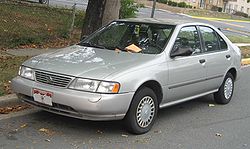
Also called Nissan Sunny
Nissan Lucino (200SX)Production 1995–1999 Assembly Smyrna, Tennessee
Aguascalientes, Mexico
Santa Rosa, Laguna, Philippines
Kuala Lumpur, Malaysia[13]Body style 4-door sedan Layout FF layout Platform Nissan B platform Engine 1.6 L GA16DE I4
2.0 L SR20DE I4Transmission 5-speed manual
4-speed automaticWheelbase 99.8 in (2,535 mm) Length 1997-99: 171.0 in (4,343 mm)
1995-96: 170.1 in (4,321 mm)Width 66.6 in (1,692 mm) Height 54.5 in (1,384 mm) Related Nissan 200SX The Sentra changed from an independent rear suspension to a torsion beam setup. Some variants were not equipped with a rear swaybar or rear disc brakes. Many of these vehicles equipped with the 1.6 liter DOHC engine that had Nissan's Variable Intake Valve Timing Control System (NVTCS) and standard 5 speed manual transmission can achieve upwards of 30-40 MPG depending on conditions. This generation is also the first generation in Mexico wearing the Sentra name.
All engines in the B14 line up came with timing chains, designed to last the vehicle's lifetime.
The B14 sentra platform was offered several trims, Base, XE, GXE, GLE, SE and SE Limited. Base and XE come with 13" steel wheels with hubcaps, GXE prior to 1998 also included 13" wheels. The only difference between trims is the GXE and up come with rear seat trunk access, rear headrests, a grip-assist handle on the passenger side, additional fabric on doors and seats as opposed to vinyl, power windows, locks, mirrors, etc. The GLE, SE, and Special Edition include in some instances leather, rear spoiler and moonroof, and keyless entry packages. All trims except the SE and SE-R have the GA16DE 1.6L engine of 115 hp (86 kW). The SE and SE-R received the SR20DE 2.0L engine with140 hp (104 kW). The 200SX SE-R came with leather wrapped steering wheel and shift knob and even Limited-Slip-Differential until 1997.
SE
The two-door Sentra was renamed as the 200SX and took the sporty SE-R model with it, though the sedan got all the performance parts (minus the limited-slip differential) in 1998 with the Sentra SE. The SE sedan came with the same 2.0 liter SR20DE engine as the SE-R.
The 1998 200SX SE-R no longer offered a Limited slip differential. This generation saw the end of assembly in Smyrna, Tennessee.
Engines
- GA16DE: 1,597cc 6,900 rpm redline 1.6 DOHC 115 hp (86 kW) @ 6000rpm, 108tq @ 4000 rpm. available in 5 speed manual/4 speed automatic
30/40mpg 5sp. man., 28/37 4sp. auto, 0-60 mph in 8.5 seconds on 95 GXE M/T: Car and Driver 6/95
- SR20DE: 1,998cc 7,300 rpm redline 2.0 DOHC 140 hp (100 kW) @ 6400rpm, 132tq @ 4800 rpm in SE & 200SX SE-R
23/31mpg 5sp. man., 23/30 4sp. auto, 0-60 mph in 8.1 seconds
Year-to-year changes
- 1995:
- 1996:
- 1997: Base, XE, GXE, Top of the line GLE
- 1998: Base, XE, GXE, (new) SE , GLE
The 1998 model year saw a minor redesign of the rear light assembly, primarily the reverse indicator lights. The front grille was changed in 1998 from horizontal bars to a large plastic mesh. In 1998 the GXE was upgraded to include 14" alloy wheels , the GLE also came with 14" wheels, and the SE and Special editions along with the 200SX SE-R came with 15" alloy rims. - 1999: XE, (Limited Edition) for GXE, SE
In 1999 the front grille was redesigned yet again, this time changed from a grille to an oval hole between the head lights.
Philippine version (1996–2002)
*FE - GA13DS: 1295 cc DOHC 16 valve carburetor (power steering only, without stereo)
*EX Saloon - GA14DE: 1392 cc DOHC 16 valve EFI (power steering only, with stereo)
*Super Saloon - GA16DNE: 1597 cc DOHC 16 valve EFI (all power, power antenna) (auto retract mirrors, SRS airbags and ABS were optional at first and later became mandatory to all units)
Due to the success of the Super Saloon, Nissan Philippines introduced the Super Touring and GTS, to compete with the Toyota Corolla TRD (limited edition) and 160HP Honda Civic SiR sedan.
*Super Touring - GA16DNE: with a sportier bodykit (lucino bumpers with foglights, sideskirt, spoiler) power steering, power windows, auto retract mirrors
*GTS - GA16DNE: successor of the Super Touring (sporty bumpers, sideskirt and spoiler) all power features, all power, power steering, power windows, auto retract mirrors
Nissan Philippines then repackaged the Sentra to a more luxurious line up in order to compete with the Toyota Corolla Altis.
*Exalta SLA - GA16DE: with reinforced extended bumpers, multi-reflector headlamps, elm wood interior accents, all power features, power steering, power windows, rear backup sensors, sapphire starlight gauges, manual transmission.
*Exalta STA - GA16DE: luxurious version of the SLA all power features, power steering, elm wood interior, power windows, auto retract mirrors, all leather seats and door panels, power sliding sunroof, automatic climate control, 2-DIN stereo with 12-Disc CD Changer, fog lights, 4 channel 4 sensor ABS, tilt and slide sunroof, retracting rear door window shades, sapphire starlight gauges.
B15 (2000–2006)
Fifth generation 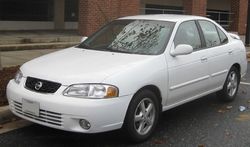
Also called Nissan Sentra 180, Production 2000–2006 Assembly Aguascalientes, Mexico Body style 4-door sedan Layout FF layout Platform Nissan MS platform[14] Engine 1.8 L QG18DE I4 (126 HP)
2.0 L SR20DE I4 (145 HP)
2.5 L QR25DE I4 (165,175 HP)Transmission 5-speed manual
6-speed manual
4-speed RE4F03B automatic (1.8L, 2.0L)l
4-speed RE4F03A automatic (2.5L)Wheelbase 99.8 in (2,535 mm) Length 177.5 in (4,509 mm) Width 67.3 in (1,709 mm) Height 55.5 in (1,410 mm) Curb weight 2,513 lb (1,140 kg) The Sentra finally crossed over into the "compact" class when the redesigned model launched in February 2000 as a 2000 model (designated as a 2001 model in Canada). When new, this redesign was considered a substantial upgrade, compared to the "cheap" economy car it replaced. Previously, the compact class had been occupied by the Altima, which moved to the mid-size class in 2002, and its wheelbase remained unchanged from the previous generation. Also to be noted is that while earlier Sentras were very similar to their Japan-market B-series Nissan Sunny twins, the B15 Sentra diverged greatly from the B15 Sunny (Nissan Super Sunny). Production shifted from Smyrna, Tennessee to Aguascalientes, Mexico, and the Smyrna production line was retooled to build the Nissan Xterra. The 2000-2001 Sentra SE with the SR20DE Roller rocker motor, which has 145 hp (108 kW) and 136 lb·ft (184 N·m) of torque, occupied the top of the line Sentra until the SE-R returned in 2002. The 1.6 L GA16DE engine was dropped in favor of the 1.8 L QG18DE, rated at 126hp. In Brazil, this engine generated 113 hp (84 kW) at 5,600 rpm and 114 lb·ft (155 N·m) at 4,400 rpm.[15] Numerous upgrades were made over the previous generation. The new model featured a new interior with higher quality plastics and more comfortable seats. The exterior was also substantially updated and now featured body-side moldings and clear headlights. The curb weight on the QG18DE-engined Sentra is 2,513 lb (1,140 kg). With the introduction of the B15 in year 2000, Nissan also introduced a CA 'Clean Air' trim only available in California. The CA trim boasts a double walled exhaust, 3 catalytic converters, quick catalyst warm up, and a radiator that has a special coating which actually changes ground level ozone (smog) into oxygen. The Sentra CA model is the only gasoline-fueled vehicle in the world to receive California Air Resources Board (CARB) super ultra low emission vehicle (SULEV) certification and obtain zero emission credits.[16]
SE-R
In 2002, a new SE-R (165 hp) was introduced, trading its SR20DE engine for the Altima's torquier but lower-revving QR25DE. The SE-R came in a base model with a 5-speed manual transmission or optional 4-speed automatic.
Other equipment include sportier-looking headlights with black surrounding the silver reflectors, and standard fog-lights.
SE-R Spec V
The Nissan Sentra SE-R Spec V is the sport compact version of the Nissan Sentra; it is the highest trim level of the Sentra. It was first produced in 2002. Its engine was the 2.5 L QR25DE unit originally created for the Nissan Altima. The engine produced 175 hp (130 kW) at 6000 rpm and 180 lb·ft (244 N·m) of torque at 4000 rpm. This power was enough to propel the car to 60 mph (100 km/h) in under 7.0 seconds (equal to the B13 SE-R's time) with 15.2 second quarter-mile (~400 m) if driven aggressively. However the extra-short gearing made 60 mph (100 km/h) unreachable in second gear.
The car came standard with a 6-speed manual transmission, a helical Torsen limited slip differential, and 17 inch wheels with performance tires. Perhaps as impressive as the car's quickness was its handling, which was the result of aggressive factory-tuning of the car's suspension and the addition of low-profile tires, which fortunately did not severely harshen the car's smoothness. It also has 296mm 22 mm (0.9 in) vented discs for the front brakes and 232 mm×7 mm solid discs in the rear, or optional Brembo brakes. Along with a standard race-inspired sporty interior, other optional features at the time included a 300-watt nine-speaker audio system (with an 8-inch (200 mm) subwoofer in the trunk) and a power sunroof.
Other equipment include sportier-looking headlights with black surrounding the silver reflectors, standard fog-lights.
Initially, for 2002 and 2003, the SE-R Spec V (along with the SE-R) was given an aggressive front fascia (styled after the Skyline GT-R) with side still extensions and rear trunk-mounted spoiler. Other notable features include a catalytic converter on the exhaust manifold, and air fuel ratios in a range, when driven aggressively, that could overheat and damage the ceramic catalyst substrate. This slight design oversight, along with a variable intake cam timing system that also functioned at light load cruising as an exhaust gas recirculation system (EGR), would allow the motor to ingest damaged ceramic catalyst substrate. The abrasive nature of ceramic in the cylinders was responsible for abnormally high oil consumption rates and a large number of engine failures secondary to low oil levels due to compromised piston ring sealing. Other areas of concern include a manifold design which contained dual intake paths. The dual runners were switched by means of a butterfly valve assembly, unfortunately in early models, the screws were prone to backing out and subsequently making their way through the motor, wreaking havoc on the piston faces, combustion chambers, and possibly valves on the way through. These two flaws however, can be easily remedied by using an aftermarket exhaust-manifold and by using a suitable adhesive (e.g. Loctite) to secure the butterfly screws. Head gasket leakage between cylinders is also very common with both engines in particularly 2002 models, but the problems are more isolated as the years go on. The QG18DE almost never suffered from the same issues as the QR25DE did.
There is some speculation surrounding the Spec V designation being a play on the GT-R V-Spec Skyline name, the speculation has been proven to be true thanks to the introduction of the R35 GT-R Spec V making the connection obvious fact. The Spec V designation is due to the fact that for some unknown legal reason Nissan cannot use the V-Spec title in the US market.
Sentra 2.5
The QR25DE was not only sported in the SE-R and SE-R Spec V trims of the B15 Sentra, but also came in the 2003 Sentra 2.5LE and 2004 Sentra 2.5S. These versions did not sport any exterior resemblance to the SE-R trims, they clone the exterior and interior of the lower trims (GXE, 1.8S), to include clear head lamps, beige-colored interior cloth, and softer suspension than the SE-R's. These trims were perfect for any driver that wanted the appearance of a regular Sentra with the power of a SE-R under the hood. The 2003 LE and 2004 2.5S didn't fill the void left by the 2001 Sentra SE (SR20 powered).[citation needed]
2004 update
2004 saw a minor face-lift for all Sentras. Gearing was changed in 2003-2006 SE-R Spec V for quicker quarter mile times of 15.2. SE-R's came only in automatic transmission from 2003–2006 and are capable of a quarter mile time of 16.0. The SE-R (Spec-V included) retained the different headlights and gained "smoked-out" brake lights.
Special Edition
The Special Edition of the Sentra 1.8L was released in 2005 and it featured a rear spoiler, SE-R interior, a 300watt Rockford Fosgate sound system, a SE-R front grille, and a front tie bar for a handling improvement. It used the same QG18DE engine and was available in automatic and a very few limited 5-speed editions.
SE-R/SE-R Spec V
For the 2004-2006 model years, cosmetic changes were made to make the Spec V look like regular Sentras from the front, although it still retained its side-skirt extensions, rear spoiler, black housing headlights and Six-Spoked 17 inch wheels (albeit different ones from 2002 and 2003 models). The 2004 model year also featured a new style of taillight which is somewhat inspired by the Skyline GT-R's quadruple taillights. In 2004 the availability of Sapphire Blue was added. In 2005 the "SE-R" badged "goose-neck" shifter handle from the previous models was replaced by an all black, leather stitched ball-top shifter. In 2005 the interior cloth option was changed from a gray and black and/or all red mesh to all black mesh. The Brembo big brake kit was also an available option of the 04-06 Spec V models, however the ABS was disconnected with this upgrade.
Engines
The 2000-2006 2.0L and 1.8L automatics use the RE4F03B transmission. The 2.5L 2.5S, SE-R automatics use the RE4F03A transmission. The 2004-2006 SE-R Spec V's horsepower were rated at 175 hp (130 kW) at 6,000 rpm and 180 lb·ft (244 N·m) of torque at 4,000 rpm.[17]
B16 (2007–present)
Sixth generation 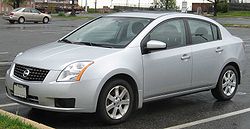
Also called Nissan Sentra 200 Production 2007–present Assembly Aguascalientes, Mexico
Santa Rosa City, Laguna, PhilippinesBody style 4-door sedan Layout FF layout Platform Nissan C platform [18] Engine 2.0 L MR20DE I4
2.5 L QR25DE I4Transmission 6-speed manual
CVTWheelbase 105.7 in (2,685 mm) Length 179.8 in (4,567 mm)
SE-R/Spec V: 180.1 in (4,575 mm)Width 70.5 in (1,791 mm) Height 59.5 in (1,511 mm)
SE-R Spec V: 59.1 in (1,501 mm)Related Nissan X-Trail
Nissan Rogue
Nissan QashqaiNissan introduced the sixth generation Sentra at the 2006 North American International Auto Show in January.[18] Classified as a mid-size sedan by the EPA thanks to its interior passenger and cargo volume of 110 cubic feet[19] (as the EPA considers "mid" or "intermediate" size a car with interior passenger and cargo volume between 110 to 119 cubic feet),[20] the Sentra is bigger in every dimension than the B15 model, being 65 mm (2.3 in.) longer, 91 mm (3.2 in.) wider, and 113 mm (4.0 in.) taller. The wheelbase is also 167 mm (5.9 in.) longer than the previous model.[21] The sixth generation also marked a change in Nissan's North American lineup, with the Nissan Versa becoming brand's entry-level model.[22] This generation is based on the C platform architecture that also underpins the first-generation Nissan Rogue, Nissan Qashqai and also the T31 Nissan X-Trail, as well as other Renault models.
In 2007 and 2008, Nissan considered marketing a hybrid version of the Sentra, particularly when the price of oil rose to over $100 per barrel.[citation needed] However the price soon retreated below $40, and Nissan decided instead to focus on future hydrogen fuel cell and electric vehicles. Nissan CEO Carlos Ghosn has indicated that he will not attempt to match Toyota and Honda in terms of hybrid models offered for retail sale. This decision has left Nissan without a compact Hybrid product to compete with Toyota Prius, the Honda Civic Hybrid, and relaunched Honda Insight. Nissan's only hybrid product on the American market is the Altima Hybrid, which competes with the Toyota Camry Hybrid and the Ford Fusion Hybrid.[23]
For 2010, the Sentra received a mid-cycle refresh. It revisions included a new, Altima-inspired grill, a revised lower fascia and slightly different headlights. In back, new taillights (though almost identical to previous years) and additional chrome trim pieces on the trunk and side moldings highlight the major changes. New trimlines are offered to balance out the prices. Inside is a new red back-lighting color for the speedometer and knobs, and a new CD player with an optional navigation system.[24] The new audio system includes iPod and USB integration on certain models, as well as a backup camera. Fog lamps are no longer standard on the 2.0S and SL model and leather seats are now only available as an option rather than standard on the SL model for 2010, which is reflected in the new, lower MSRP. The Brazilian export variant features a flexible fuel engine and retractable side mirrors were adopted from the Nissan Versa.
The B16 generation was introduced in the Philippines[25] (where it is sold as Sentra 200 and replaces Pulsar-based N16 model)[26] and Argentina in 2010.[27] Until March 2011, the Sentra has sold 948 units in Argentina.[28][29][30][31]
SE-R (2007–)
Nissan introduced a new version of the SE-R to the North American market for the 2007 model year. The SE-R is available in two versions: SE-R base and SE-R Spec V. Both get four-wheel disc brakes in place of the standard Sentra's disc/drum setup, unique interior and exterior trim and 17 inch alloy wheels. Both are powered by the 2.5 liter QR25DE engine.
The base model is rated at 177 hp (132 kW) at 6000 rpm and 172 lb·ft (233 N·m) at 2800 rpm and comes exclusively with Nissan's X-CVT continuously variable transmission and steering wheel-mounted paddle shifters. The SE-R base model starts at $19,400 (MSRP).
The SE-R Spec V is rated at 200 hp (149 kW) at 6600 rpm and 180 lb·ft (244 N·m) at 5200 rpm and comes with a 6-speed manual and optional limited-slip differential. It is capable of 0-60 mph times of 6.7 seconds and a 1/4 mile time of 15.1 seconds at 92.6 mph.[32] The Spec V also gets red front seat belts, bigger front brakes and a stiffer suspension. The SE-R Spec V model starts at $19,900 (MSRP).
FE+ 2.0 SR (2009–)
It is a Sentra 2.0 S with sport-inspired exterior enhancements, including SE-R-style front and rear fascias, side sills and rear spoiler, sport grille, dark chrome bezel headlights and dark smoked bezel taillights, 16-inch aluminum-alloy wheels, exhaust tip, and "SR" trunk lid badge. It is available in 6 exterior colors, including the limited Sentra SE-R/SE-R Spec V colors, and will be offered with a Charcoal cloth interior.
The car was sold for US$17,760, same as the Sentra FE+ 2.0 S model.[33]
Flex fuel
Nissan launched in August 2009 in Brazil a FFV variant of the B16 Sentra. It features the same MR20DE engine, but capable of running on hydrated ethanol (E100) or a blend of gasoline with 20 to 25 percent of anhydrous ethanol (mandatory blend since 1993)[34] or a mix of both in any proportion.[35]
The engine received a new electronic control unit (ECU) supplied by Bosch and ethanol's corrosive action resistant internal components. Among these new parts are the intake and exhaust valves and sealants made with new materials, the first ring of pistons made with anodized steel, more resistand connecting rods, fuel injectors suitable for use in ethanol and double-layer exhaust gas oxygen to increase the moisture resistance of the fuel. The power rose to 141 hp (143 cv) both in gasoline and ethanol. Compression ratio of 9.7:1 was kept unchanged.[35]
At the time it was launched, there was some controversy regarding the possibility of vehicles equipped with CVT transmission be converted to flex fuel, since this was the statement that was made by Honda Motor of Brazil in the launch of the second generation Honda Fit in Brazil. During the 2008 upgrade of the Honda Fit,the CVT system was replaced by a conventional automatic transmission and according to the manufacturer it was not possible to attach the CVT transmission infinite relations to a flex fuel engine. Honda's decision to change the type of transmission reduced manufacturing costs and Brazilian auto press inquired the truth of that statement following the release of the CVT-equipped Sentra FFV.[36][37][38]
Name variations
Asian Version 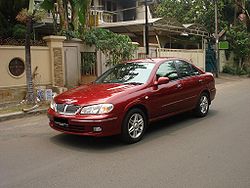
Also called Nissan Sunny
Nissan Sunny Neo
Nissan Bluebird Sylphy
Nissan Sentra Exalta
Nissan PulsarProduction 2000–2004 Assembly Santa Rosa, Laguna, Philippines
Miaoli, Taiwan
Kuala Lumpur, Malaysia
Samut Prakan, ThailandBody style 4-door sedan Layout FF layout Platform Nissan FF-S platform / N16 Engine 1.8L I4 Transmission 4-speed automatic
5-speed manualWheelbase 2,535 mm (99.8 in) Length 4,470 mm (176.0 in) Width 1,695 mm (66.7 in) Height 1,440 mm (56.7 in) In countries such as New Zealand, vehicles from both the Nissan Sunny and Nissan Pulsar ranges were marketed as a single model range (With the exception of the Pulsar, which included an EXA model identical to the North American Pulsar), the "Nissan Sentra"—which differed (apart from the station wagon) from the models sold under the same name in the United States.
The Sentra name was adopted in several other countries, such as New Zealand, where it was used for the Nissan Pulsar range from 1986 (though, interestingly, the station wagon version was actually a rebadged Nissan Sunny California). The Sentra name continued to be used in New Zealand for the Pulsar until 1998, just as Almera was used in Europe. After 2002, the Japanese Pulsar name was adopted.
Unlike the North American version, a hatchback was offered; engines offered were 1.4 L, 1.6 L and 2.0 L petrol engines; a diesel was available in Europe. Some were sold in the Republic of Ireland.
In Taiwan, Yulon has built its licensed version of the Sunny as the Sentra since 1990. The current Taiwan-market Sentra reflects the styling of the Japanese-market Bluebird Sylphy (also the Almera/Pulsar sedan but with a luxury emphasis). This N16 model is called Sentra M1.
In Indonesia, the first and second generations Sentra were the Sunny-based B12 and B13 models respectively. The 1988-1990 B12 was offered as SGX Sedan and SR Coupe. The B13 was nicknamed Sentra Genesis, only sold as sedan from 1991 to 1996.
After skipping 6 years, Nissan re-introduced the Sentra in Indonesia in 2002. The Sentra is now based on the N16 Pulsar or Nissan Bluebird Sylphy. It's powered by 1.8 liter QG18 engine matched to 4 speed automatic transmission. The Sentra was only offered in luxury Super Saloon trim level, loaded with standard ABS and leather interior. However, it was sold only in small numbers until 2004.
Today, the Philippines also uses the Sentra name for its version of the Pulsar. The N16 model is known as Nissan Sentra Exalta (available from 2001–2003). The early model is similar to JDM Bluebird Sylphy. Nissan Philippines introduced a model with new headlights and tail lights, the facelift model was later renamed back to Sentra or commonly referred to as N16 Generation 2 is the same as Sunny Neo in Thailand. The current N16 Sentras have QG series powerplants and are sold in three variants namely the 1.3L GX (QG13DE), GSX (QG16DE) and the top of the line GS(QG16DE). Starting 3rd Quarter of 2010, The Nissan Sentra B16 became available in the Philippines included in the new line-up of automobiles from Nissan Motor Philippines (NMPI). It is called the new Nissan Sentra 200 with an MR20 engine available in two variants: 6-speed Manual and Xtronic CVT transmission.
References
- ^ "Fuel Economy Guide 2009", U.S. Environmental Protection Agency, 2009, accessed July 25, 2010.
- ^ a b c d "Nissan building popular Sentras in Smyrna, Tenn.", Reading Eagle, p.55, May 29, 1985, accessed April 19, 2011.
- ^ "Nissan To Introduce New Economy Car", The New York Times, April 21, 1982, accessed April 19, 2011.
- ^ a b Popular Mechanics, July 1982, p. 124
- ^ a b Mateja, James. "Nissan introduces new car", Chicago Tribune, May 2, 1982, accessed April 19, 2011.
- ^ "Nissan's move to front-wheel drive paying dividends" The Day, June 11, 1982, accessed April 19, 2011.
- ^ "Luxury Car Sales Bucked Trend, Grew 5% In '82" Ocala Star-Banner, January 7, 1983, accessed April 19, 2011.
- ^ "Cutlass nation's top-selling car" Lodi News-Sentinel, January 7, 1984, accessed April 19, 2011.
- ^ "Imports add more spice to US market" The Milwaukee Journal, November 16, 1983, accessed April 19, 2011.
- ^ "Sentra remains America's import leader" Record-Journal, February, 1985, accessed April 19, 2011.
- ^ "Consumer Reports recommends 5 subcompact, 9 sports cars" Gainesville Sun, May 12, 1985, accessed April 19, 2011.
- ^ "Chevrolet Celebrity Tops List In Auto Safety Crash Testing" Sarasota Herald-Tribune, April 27, 1983, accessed April 19, 2011.
- ^ "Nissan. Nissan In Malaysia". Car-cat.com. http://car-cat.com/firm-797.html. Retrieved 2010-07-25.
- ^ Shiniti, Ishida. "日産、MSプラットホームを2002年までに小・中型車に完全導入", Response, September 20, 2000, accessed April 19, 2011. (Japanese)
- ^ "Testes: Nissan Sentra GXE", Quatro Rodas, October, 2004, accessed April 19, 2011. (Portuguese)
- ^ "2000 Nissan Sentra CA Claims Title As the Cleanest Gasoline-Fueled Car", The Auto Channel, January, 2000, accessed May 27, 2011.
- ^ "2004 Sentra Receives Facelift and Interior Enhancements, Maintains Popularity in the Small Car Segment", 2004, accessed April 18, 2011.
- ^ a b "DETROIT SHOW: Nissan launches two production cars and a sporty 'concept'" just-auto.com, January 10, 2006, accessed May 1, 2011.
- ^ "2010 Nissan Sentra: Big car feel in a small package" Mountain Democrat, September 10, 2010, accessed May 1, 2011.
- ^ Form EIA-886 - Annual Survey of Alternative Fueled Vehicles - 2010 U.S. Energy Information Administration, accessed May 1, 2011.
- ^ "Test Drive: 2007 Nissan Sentra 2.0S" Autos.ca, May 11, 2007, accessed May 1, 2011.
- ^ MacKenzie, Angus. "2007 Motor Trend Car of the Year: Testing and Finalists" Motor Trend, December, 2006, accessed May 1, 2011.
- ^ Gold, Aaron. "2010 Ford Fusion Hybrid" just-auto.com, accessed May 1, 2011.
- ^ "detnews.com | Autos | Sneak Peeks". Apps.detnews.com. http://apps.detnews.com/apps/autoreviews/index.php?action=sneak&id=34748. Retrieved 2009-05-05.
- ^ "Nissan Motor Philippines launches Sentra 200", TopGear.com.ph, June 20, 2010, accessed May 1, 2011.
- ^ Roces, Iñigo. "Not In the Specs", AutoIndustriya.com, June 30, 2010, accessed May 1, 2011.
- ^ "Lanzamiento: Nissan Sentra", Argentina Autoblog, October 20, 2010, accessed May 1, 2011. (Spanish)
- ^ "Así fueron las ventas de marzo 2011", Argentina Autoblog, April 4, 2011, accessed May 1, 2011. (Spanish)
- ^ "Así fueron las ventas de febrero 2011", Argentina Autoblog, March 3, 2011, accessed May 1, 2011. (Spanish)
- ^ "Así fueron las ventas de enero 2011", Argentina Autoblog, February 3, 2011, accessed May 1, 2011. (Spanish)
- ^ "Así fueron las ventas totales de 2010", Argentina Autoblog, January 4, 2011, accessed May 1, 2011. (Spanish)
- ^ Jacquot, Josh. "Full Test: 2007 Nissan Sentra SE-R Spec V", Edmunds.com, March 6, 2007, accessed May 1, 2011.
- ^ Korzeniewski, Jeremy (2009-03-11). "Nissan announces new 2009 Sentra FE+ 2.0 SR". Autoblog.com. http://www.autoblog.com/2009/03/11/nissan-announces-new-2009-sentra-fe-2-0-sr/. Retrieved 2010-10-03.
- ^ "Lei Nº 8.723, de 28 de Outubro de 1993. Dispõe sobre a redução de emissão de poluentes por veículos automotores e dá outras providências", Casa Civil da Presidência da República, accessed May 1, 2011. See article 9th and modifications aprroved by Law number 10.696 from July 2, 2003, increasing the upper limit to 25 percent. (Portuguese)
- ^ a b "Linha 2010 do Nissan Sentra fica mais equipada e custando menos", Mecânica Online, accessed May 1, 2011. (Portuguese)
- ^ "Sentra com motor flex chega às lojas", G1, August 5, 2009, accessed May 1, 2011. (Portuguese)
- ^ "Nissan Sentra 2010 chega mais prático, mais completo e mais barato", WebMotors, November 23, 2009, accessed May 1, 2011. (Portuguese)
- ^ "Nissan Sentra Flex 2010 tem preços entre 55.290 e 72.890 reais", NoticiasAutomotivas.com.br, August 6, 2009, accessed May 1, 2011. (Portuguese)
External links
- Aftermarket parts for All Sentra's
- Online Forum for Sentra's
- Official site
- 2007 Nissan Sentra review at About.com
- 2007 Nissan Sentra SE-R review at About.com
- 2007 Mexican Nissan Tsuru
- Foro Tecnico Nissan
- Nissan Motor Philippines, Inc.
- Nissan Sentra Replacement Parts
Nissan Motor Company Vehicles Current370Z • Advan • Altima • Aprio • Armada • Atlas • Bluebird • Bluebird Sylphy • Cabstar • Caravan • Civilian • Clipper • Cube • Dualis • Elgrand • Frontier • Freeson • Fuga • GT-R • Juke • Lafesta • Leaf • Livina Geniss • Maxima • March • Murano • Moco • Navara • Note • NV200 • NV400 • Otti • Paladin • Pathfinder • Patrol • Qashqai • Quest • Rogue • Safari • Sentra • Serena • Skyline • Teana • Tiida • Titan • Urvan • Versa • Wingroad • X-Trail • XterraPastDC-3 • 100NX • 1200 • 310 • 180SX • 200SX • B-210 • 240SX • 240Z • 280ZX • 300C • 300ZX • 350Z • 510 • 810 • Almera • Almera Tino • Altra (EV) • Avenir • Auster • Bassara • Be-1 • Caball • Cablight • Cedric • Cefiro • Cherry • Cima • Crew • Datsun Truck • Echo • Expert • Fairlady • Figaro • Gazelle • Gloria • Hardbody Truck • Hypermini • Homy • Interstar • Junior • Largo • Laurel • Leopard • Liberty • Mistral • Multi • NX • Pao • Pintara • Pino • Platina • Prairie • Presage • Presea • Primera • President • Pulsar • Pulsar GTI-R • R390 GT1 • R'nessa • Rasheen • Roadster-Road Star • S-Cargo • Saurus • Saurus Jr • Silvia • Sileighty • Skyline GT-R • Stanza • Stagea • Sunny • Terrano • Terrano II • Vanette • VioletConcept126X • 216X • 270X • 300 Bambu • 315-a • AA-X • Actic • AD-1 • AD-2 • AL-X • Alpha T • Amenio • AQ-X • AP-X • ARC-X • AXY • AZEAL • Bevel • Boga • C-Note • Chapeau • Chappo • Cocoon • CQ-X • Crossbow • CUE-X • Cypact • Duad • Dunehawk • Effis • ESV • Evalia • EV Guide II • EV Truck • FEV • FEV-II • Foria • Forum • Fusion • Gobi • GR-1 • GR-2 • GT-R • ideo • Intima • Jikoo • Judo • Jura • Kino • KYXX • Land Glider • LEAF • LUC-2 • MID4 • Mixim • mm.e • Moco • Nails • NCS • NEO-X • NRV-II • NX-21 • NV2500 • Pivo • Pivo 2 • Qazana • Redigo • Round Box • Serenity • Sport Concept • Stylish VI • Terranaut • Tone • Townpod • Trailrunner • TRI-X • URGE • UV-X • XIX • XVL • Yanya • ZarootEngines GRX-3 • UD12 • VRT35Marques Nissan • InfinitiSubsidiaries
and divisionsSee also ATTESA • Datsun • HICAS • Prince • Renault-Nissan Alliance • Nissan Shatai • UD Nissan Diesel • VVL • VVEL • dCi
Nissan road car timeline, United States and Canadian markets, 1980s–present Type 1980s 1990s 2000s 2010s 0 1 2 3 4 5 6 7 8 9 0 1 2 3 4 5 6 7 8 9 0 1 2 3 4 5 6 7 8 9 0 1 2 Subcompact Micra 210 Sentra Sentra Sentra Sentra Versa Versa Compact 310 Sentra Sentra 510 Stanza Stanza Stanza Altima Altima Leaf 810 Maxima Maxima Mid-size Altima Altima Maxima Maxima Maxima Maxima Full-size Maxima Sport compact Pulsar NX Pulsar NX NX 200SX 200SX 200SX 240SX 240SX Sports 280ZX 300ZX 300ZX 350Z 370Z GT-R (R35) Categories:- Nissan vehicles
- 1980s automobiles
- 1990s automobiles
- 2000s automobiles
- 2010s automobiles
- Vehicles introduced in 1982
- Compact cars
- Coupes
- Front wheel drive vehicles
- Hatchbacks
- Sedans
- Subcompact cars
- Sport compact cars
- Station wagons
- Vehicles with CVT transmission
- Partial zero-emissions vehicles
- Motor vehicles manufactured in the United States
Wikimedia Foundation. 2010.

